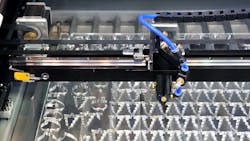Crystal Ball 2025: Complex manufacturing challenges and opportunities in the new year
A note from Scott Achelpohl, managing editor of Smart Industry:
Welcome to the Crystal Ball Report for 2025, which is appearing in this web space into January as a series of contributed pieces from esteemed experts in manufacturing technology.
We've invited these thought leaders to look into their "crystal balls" and tell us what's ahead (with an emphasis on data, AI, and cybersecurity). So please enjoy the series and, from all of us at SI, have a prosperous and profitable new year.
What's in the Crystal Ball Report for 2025:
- Crystal Ball preview: Top cybersecurity risks in 2025 and beyond, by Carlos Buenaño, Armis
- The opportunity for AI-powered digital transformation, by Aaron Merkin, Fluke Reliability
- Cybersecurity top of mind for utilities, by Sally Jacquemin, Aspen Technology
- New year will demand streamlined data management, by Dwaine Plauche, Aspen Technology
- Workforce … industrial metaverse … reshoring … sustainability … China … all 2025 focus areas, by Ethan Karp, MAGNET
- Security in 2025 won't be just for the IT team, by Joe Anderson, TechSolve
Regulations. AI. Customization demands. For manufacturers of complex products, there’s never a dull moment. As challenges and changes come at them rapid-fire, they will need to set priorities to not only keep pace with but shoot past the difficulties and embrace trends that lead to success.
Best of 2024: SI looks back at our favorite features
This includes configurability, modularity and embracing AI, none of which are particularly easy or cheap. However, failure to heed market demands can lead to company failure.
Let’s look into the near future to see what manufacturers can expect and prepare for in 2025.
Configurability will become a bigger priority. As we saw in a recent survey of product lifecycle management professionals conducted by CIMdata, configurability has become a bigger priority, and we anticipate that trend will continue in 2025. This will drive the need for new ways to support customization, as traditional processes and tools won’t suffice.
Many manufacturers still try to manage configurable products and product variants as if they were standard products, but managing configurable products requires a different approach. This leads to the next prediction.
More of the Crystal Ball series:
- Insights on 2025 from talks with manufacturers, by Josh Cranfill, Quickbase
- AI, automation, and insider threat detection, by Chris Scheels, Gurucul
- Business leaders should look inward to identify what they can control, by Michael van Keulen, Coupa
- Cybersecurity trends that will reshape private content security, by Patrick Spencer, Kiteworks
- Configurability, modularity, and AI: The 2025 challenges, by Damantha Boteju, Henrik Hulgaard, and Daniel Joseph Barry, Configit
- The rise of resilient manufacturing, by Aron Brand, CTERA
- 2025 prediction thread, Part 1, by various authors
- 2025 prediction thread, Part 2, by various authors
- Your opinion counts: Results from SI's reader poll on 2025, by Scott Achelpohl, Smart Industry
There will be a rise in adoption of modularity. We’ll see an increase in modularity due to the expanded demand for customization, increased regulations and compliance mandates. For example, sustainability regulations that require reuse and recyclability, such as those we see in the U.S. and European Union, are easier to meet with a modular approach.
Episode 4 of (R)Evolutionizing Manufacturing: The Art of the Possible and The Art of the Practical
Many early adopters have already implemented a modular approach to their products, and we’ll see more adoption in the new year, as modularity benefits manufacturers by reducing time, effort and costs. It enables them to meet customization demands more cost-effectively by reusing modules (collections of features or pre-assembled parts) rather than custom engineering.
Adopting modularization can be demanding, as it requires process changes, but with the combined compelling events of regulations and competition, manufacturers can justify the investment and reap the benefits.
Forward-thinking manufacturers have already recognized this and are adopting new approaches centered on modularity and transitioning from engineer-to-order (ETO) to more customize-to-order (CTO) approaches that better meet their customers’ needs and enable faster response and delivery of solutions with minimal impact on engineering resources.
The rise of the digital configuration thread. The digital thread approach is rapidly becoming the data foundation for managing both standard and configurable products.
As we move into 2025, we see this concept playing a bigger role. That’s because a digital thread can help manufacturers by providing end-to-end insight and traceability, enabling analysis and optimization of product portfolios and supporting digital twins.
The AI trap: Why manufacturers fail without the right data
However, achieving this approach often requires manufacturers to cobble together information from multiple bills of material (BOMs) in varying formats that reside in disparate systems—typically under the purview of multiple departments.
That can lead to misunderstandings, inconsistencies, control issues and maintenance concerns, but configuration lifecycle management (CLM) produces a “digital configuration thread” that can help manufacturers manage product configurations better.
Manufacturers will lean into Generative AI as augmentation and employee enablement. One of the significant business benefits of Gen-AI is reducing time to market while giving employees time back to work on bigger, more creative projects.
Video: The biggest manufacturing stories in 2024
Gen-AI helps accelerate business processes and reduce mundane work, enabling employees to focus on being creative and putting more effort into better human interactions and collaboration. The most competitive companies in 2025 will be those who understand the power of artificial intelligence and copilots to build on the strength of their employees.
Manufacturers will look to configuration to help with workforce challenges. Demands on manufacturers have never been higher, but U.S. manufacturers are struggling with a workforce gap.
As seasoned workers hit retirement age, manufacturers will need to ensure they can capture the institutional knowledge of these employees in a more efficient way. That means moving away from a document- and experience-driven process to capture information from individual contributors.
Lessons in continuous improvement in 2024: Failures, fixes and did you consider this?
A CLM approach is one way to do this, laying the foundation for better collaboration and innovation by centralizing product configuration information so it can be shared among multiple departments. This capability lessens the sting of retiring pros and the fear of losing a company’s brain trust.
Embrace change, embrace the future
Any industry that relies on technology has had to adapt to change, which can be particularly hard for manufacturers using legacy technologies and manual processes. Today’s manufacturing sector needs tools to support customization, meaning greater modularity adoption. This, in turn, enables the time- and money-saving shift from engineer-to-order (ETO) to more customize-to-order (CTO) capabilities and processes.
Podcast: What awaits manufacturing in 2025
Today’s manufacturers need a strong data foundation to gain the insight and traceability that will propel them forward; CLM acts as a strong partner here. Gen-AI will help save the day but won’t replace seasoned manufacturing pros. However, as more of those pros retire, manufacturers can address the workforce gap with the right tools to make configurable products easier to achieve.
About the Author

Damantha Boteju
Damantha Boteju is chief product and technology officer at Configit, provider of configuration lifecycle management (CLM) solutions and a supplier of software for the configuration of complex products.

Henrik Hulgaard
Henrik Hulgaard is VP of product management and co-founder of Configit. He is an occasional contributor to Smart Industry, including SI's Crystal Ball Report.

Daniel Joseph Barry
Daniel Joseph Barry is VP of product marketing at Configit.

